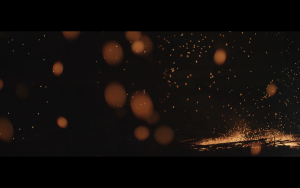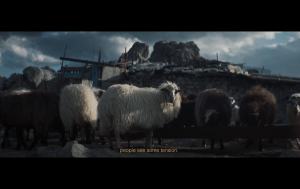Rocket Wars is a short film by the New York City based production company, Variable. The film falls categorically into what is best described as a cinematic-documentary hybrid, a style particularly innovated and championed by the team at Variable.
Rocket Wars, set in the Greek village of Vrontados on the island of Chios, tells the story of a more than centuries tradition wherein the the parishioners of two Greek orthodox churches exchange volleys of rockets aimed at each other. This annual holiday is known as Holy Saturday.
From beginning to climax the film is a clinic, from a narrative perspective, in the art of stage-setting and tension-building. What I aim to do in this blog post is point out instances where shot selection and juxtaposition in the editing process created that tension in the first and second acts and helped to craft a meaningful story.
For more background and a technical breakdown of the production, click here.
Act I
The very first shot of the film is a gorgeous low-angle dolly out of a gilded apse in a Greek orthodox church, this is overlaid by an ominous quote by St. Augustine. This first shot immediately introduces us to stakes to consider for the rest of the film, war and peace, or chaos and order.

The order and security represented by images of the church is juxtaposed by the chaos and violence of the ocean waves. This juxtaposition is further pushed by the presence of a less stable camera in the ocean scenes.

As we begin to see shots of the village, it is apparent by the absence of and life forms in the streets or on balconies, that there is this sense of impending doom or violence amongst the community.

It is important to note that it is the dialogue between these shots of the church, ocean, and village allows the editor to forgo sequencing back-to-back shots within a scene in favor of an interwoven, metaphorical sequence.
Act II
As we are introduced to the main characters of the film, the content shifts but the metaphor continues to build. As we see a man reflect in serene anticipation on what is to come, these shots are interrupted by poetic images of a firey chaos. This cut acts as a window into the mind of this character.

In the exterior shots we experience heavy winds and more shaky camera. A group of unnerved sheep amidst the winds invokes an obvious religious reference, and these sheep almost act as a stand in for the community members who are otherwise absent.
Without this beautiful interplay of poetic imagery building to the rocket-filled climax, the film, while still being visually stunning I am sure, would have fallen flat as a narrative. Here the filmmakers succeed in a textbook example of showing us what doesn’t need to be told and telling us what doesn’t need to be shown.


Leave a Reply